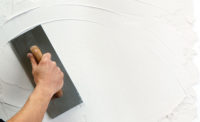Polyvinyl chloride, commonly abbreviated as PVC, is the world’s third-most widely produced synthetic plastic polymer, after polyethylene and polypropylene. PVC comes in two basic forms: rigid and flexible. In building construction, the rigid form of PVC is used for pipe and in profile applications such as doors and windows, while the flexible version is commonly used as insulation in electrical wires or in flooring, or as an alternative to rubber. PVC accessories for stucco, EIFS and drywall—sometimes referred to simply as “vinyl” accessories—have been around for 30 years, emerging first as window and door moldings. However, today, PVC accessories are making a strong move into the traditional galvanized accessory market by introducing color into the pallet of the designer.
Fluctuations in the price of galvanized steel and the elevated prices of pure zinc alloy make vinyl accessories an attractive and budget-friendly option for builders and contractors. Vinyl accessories are also sustainable, as recycled PVC is broken down into small chips, impurities are removed and the product is refined to make pure white PVC. It can be recycled roughly seven times and has a lifespan of around 140 years.
The various polymers most manufacturers use to make PVC components meet the following industry standards:
- ASTM D4216 – Standard Specification of Rigid Poly (Vinyl Chloride) (PVC) and Related PVC and Chlorinated Poly (Vinyl Chloride) (CPVC) Building Products
- ASTM D1784 – Standard Specification for Rigid Ploy (Vinyl Chloride) (PVC) Compounds and Chlorinated Poly (Vinyl Chloride) (CPVC) Compounds
These two standards are referenced in ASTM C1063 Standard Specification for Installation of Lathing and Furring to Receive Interior and Exterior Portland Cement-Based Plaster, Section 6.2.4 PVC Plastic. Additionally, the thicknesses of accessories for Portland cement plaster are listed in Section 6.2.2, as spelled out in Table 1.
Color Considerations
Though PVC is naturally white in color, builders and contractors have traditionally been able to integrate the material into various designs by painting it. For example, reveals and soffit vents are almost always painted or coated with an acrylic finish, while casing and corner beads commonly receive the same treatment. Although painting is a solution for the initial application, builders and contractors should be aware of the future maintenance required to retain their desired look. For conditions where the PVC will not be painted, it is important ensure that the installed components are compatible on color variation and are acceptable to the owner.
However, for those owners who would not prefer to have the white color, or maintain the upkeep of a paint finish, the integration of color into the vinyl accessory may be just the alternative they are looking for.
PVC materials can be extruded in color using two different approaches:
- Introducing color PVC re-grind into the melting process, thereby extruding the entire part in that color vinyl completely.
- Co-extruding the accessory using the “cap-stocking” method, where a very thin (approximately .5-10 mil) layer of solid color PVC is laminated to the surface of the standard white PVC profile, fused together to form a single monolithic component. The cap stock method provides color PVC to only the area where the component is exposed to view.
To ensure consistency of colors, many manufacturers employ the Pantone Matching System. The PMS is a proprietary color space used in a variety of industries, primarily printing and sometimes in the matching of colored paint, fabric and plastics. By standardizing the colors, different manufacturers in different locations can refer to the Pantone System to make sure colors match without direct contact with one another. (Chart 1)
Color PVC accessories provide the following benefits to the building owner:
- No need to paint the accessories in the field, or perform ongoing maintenance and color matching
- They are UV-resistant and will not chalk or fade within their color spectrum
- Most vinyl manufacturers produce common colors to match cementitious mixtures such as tan, brown and gray.
- The colors can be custom blended to match any pallet, using a Pantone (or other) color chart
Time-Tested Durability
In addition to being economical and adaptable to various design requirements, PVC is a very durable material. PVC accessories offer outstanding UV resistance due to the addition of Titanium Dioxide during the manufacturing process. In addition to giving the vinyl its white color, TiO2 also provides great protection from UV breakdown. (It’s also a major ingredient in sun block for human protection from the sun.) This chemistry has been employed since the late ’80s.
Vinyl within this class of compounds has fire-mitigating properties. Vinyl building products are based on a polymer that, by its nature, resists combustion. Rigid vinyl building products are slow to ignite, their flame spread is slow and they cease to burn after the flame source is removed. These properties are evaluated through ASTM E-84 Standard Test Method for Surface Burning Characteristics of Building Materials. The purpose of this test method is to determine the relative burning behavior of the material by observing the flame spread along the specimen and reporting on both flame spread and smoke developed. However, there is not necessarily a relationship between these two measurements.
Operating Temperatures
PVC compounds extruded and installed on building exterior facades have some limits as it relates to their use in extreme cold and hot climates. For example, vinyl components become brittle in cold (approximately 15-20 degrees Fahrenheit) temperatures and can fracture when struck during nailing and installation. In these low temperatures, it’s recommended that PVC accessories be kept in their carton, or in a trailer on the jobsite, until installed. In extremely hot climates, where temperatures often stay above 100 degrees Fahrenheit across the day and night, the PVC can bake in the wall and become brittle after installation. The use of vinyl accessories is not recommended in these environments. It’s important to note that PVC accessories will move with the wall and the plaster they are embedded in and do not express their individual coefficient of expansion and contraction.
Lower Maintenance Costs
With PVC accessories, builders no longer need to worry about long-term maintenance or oxidation that can occur with galvanized metal. Manufactured stone veneer, a product that has the appearance of natural stone but is manufactured with concrete, is increasing in popularity giving commercial, residential and landscape applications a rich, upscale look. Most of these stone veneer systems are installed like a stucco wall system, with weather barriers, metal lath, flashing, trims and accessories. These exposed galvanized accessories are susceptible to oxidizing from trowel scrapes on their surfaces. When galvanized steel is scratched, the bare metal is exposed to moisture, which interacts with the atmosphere. The surrounding zinc coating attempts to neutralize the rust, but can only do that for so long before the rust takes over. Left untreated, the galvanized accessory will corrode.
By contrast, vinyl accessories will never rust because there is no ferrous metal to oxidize.
Scraping trowels do not affect the PVC trims, so future maintenance on the accessory is negligible. Now, with the introduction of colored vinyl compounds, these accessories can easily match stone and mortar colors such as tan, brown and gray, making them a strong choice for large homebuilders who are looking for color blending and low maintenance on their thin stone facades.
With the advancements of PVC in the last 15 years, coupled with the advent of color compounds, vinyl accessories are emerging as a viable material choice for stucco, EIFS/DEFS, manufactured stone and drywall systems. PVC costs are competitive with galvanized trims, with color vinyl adding only pennies per foot to the initial costs. These color and application trends reveal why more builders are rediscovering vinyl as an attractive material of choice for exterior cladding systems.








